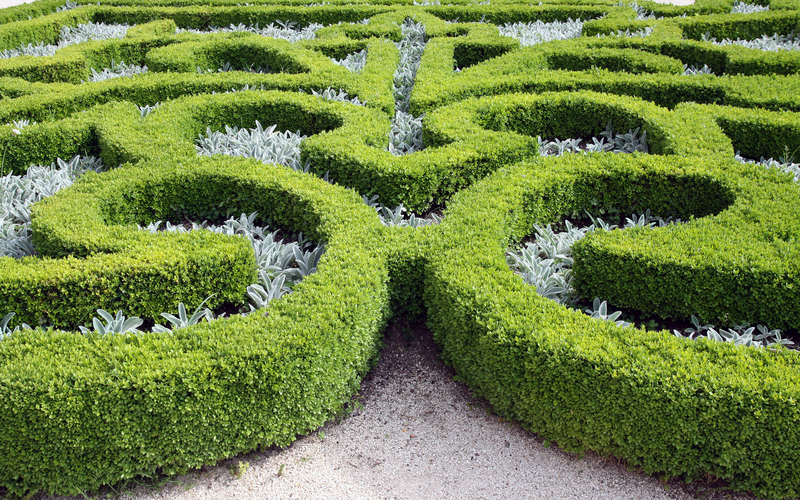Creating Safe and Fun Outdoor Spaces for Kids
Posted on 27/08/2025
Creating Safe and Fun Outdoor Spaces for Kids
Encouraging children to play outside is essential for their physical health, imagination, and overall well-being. As parents, guardians, or community members, designing safe and fun outdoor spaces for kids ensures that children can enjoy the outdoors while being protected from avoidable risks. With thoughtful planning, you can create an inviting backyard, garden, playground, or communal park that inspires exploration, learning, and laughter. In this comprehensive guide, we'll explore how to design secure and exciting outdoor environments that help kids of all ages thrive.
Why Outdoor Play Is Vital for Children
Outdoor activities play an indispensable role in a child's development. Here are some key benefits:
- Physical Health: Running, jumping, and climbing improve strength, coordination, and cardiovascular health.
- Mental Well-being: Nature lowers stress and fosters emotional resilience.
- Creativity and Social Skills: Unstructured play helps children build friendships, negotiate, and overcome challenges together.
- Connection to the Environment: Exposure to plants, insects, and animals sparks curiosity and respect for nature.
Challenges in Building Safe Outdoor Spaces
While creating fun environments is exciting, ensuring safety is paramount. Hazards such as sharp objects, toxic plants, poor surfaces, or unsafe equipment can compromise a child's security. Addressing these issues with careful design and ongoing vigilance is crucial to cultivating safe outdoor play spaces for children.

Elements of a Safe and Fun Outdoor Space for Kids
Designing a backyard or community play area involves several considerations. Here are the essential elements:
- Age-Appropriate Play Equipment
- Soft Landing Surfaces
- Safe Boundaries and Fencing
- Shade and Weather Protection
- Secure Storage for Tools and Chemicals
- Engaging Natural Features
Let's dive into each of these components and offer tips for optimizing outdoor play spaces for children's safety and enjoyment.
1. Age-Appropriate Play Equipment
Children's abilities and interests evolve rapidly. To maximize both fun and security, choose equipment that matches the age and skill level of the children using the space.
- Toddlers: Opt for low-height slides, toddler swings, and sandboxes with rounded edges. Avoid equipment with small parts or sharp hardware.
- Preschoolers: Introduce slightly taller slides, climbing frames, and ride-on toys. Still, keep heights low and surfaces soft.
- Elementary-age kids: Install monkey bars, zip lines, and more complex climbing structures. Supervise closely and ensure surfaces can cushion falls.
Inspect play equipment regularly for signs of damage such as rust, splinters, or loose bolts. Promptly repair or replace any hazardous items to maintain a safe outdoor environment for kids.
2. Soft Landing Surfaces
Falls are a common part of outdoor play. Soft surfaces reduce the risk of injuries and should be a priority in any children's play area.
Recommended materials include:
- Rubber mulch or mats
- Engineered wood fiber
- Poured-in-place rubber
- Pea gravel (for older children only)
- Artificial turf designed for play areas
Natural grass, while attractive, can become slippery or uneven, increasing trip hazards or muddy messes. Make sure all play equipment is installed over a minimum depth of 12 inches of impact-absorbing material, extending at least 6 feet in all directions from the play zone.
3. Safe Boundaries and Fencing
Children are naturally curious and may wander beyond designated play areas. Adequate boundaries and fences add a crucial layer of safety, especially in homes near traffic, ponds, or dense vegetation.
- Choose sturdy fencing at least 4 feet high to keep children in and stray animals out.
- Use gates with child-proof latches.
- Check for sharp wire, splinters, or gaps large enough for children to squeeze through.
- Landscape with shrubs or flowers inside the fence for added visual appeal and soft deterring edges.
Boundaries also help establish zones, such as active play, quiet rest, and garden exploration, for different activities and safety needs.
4. Shade and Weather Protection
Sun safety is vital for children's delicate skin. Provide shade to reduce direct UV exposure and keep play areas cool. Ways to add shade include:
- Planting fast-growing, non-toxic trees
- Install pergolas, shade sails, or canopies
- Using large umbrellas for sandboxes or seating areas
- Adding portable pop-up tents for flexible coverage
Remind children to wear sunscreen, hats, and drink plenty of water during warm weather. In colder months, provide windbreaks or semi-sheltered playhouses to encourage outdoor time year-round.
5. Secure Storage of Tools and Chemicals
Yard tools, garden equipment, pesticides, and fertilizers should never be accessible to children. Keep these items in locked storage sheds or high, latched cabinets. Label all chemicals clearly and store them away from play areas. Regularly walk the play space to check for forgotten tools, open garden gates, or spilled substances.
6. Engaging Natural Features
Natural elements are incredibly important in designing stimulating and fun outdoor areas for kids. Rocks, logs, sand, water, and garden beds engage all the senses and encourage imaginative play. Consider these additions:
- Build a mud kitchen for creative "cooking" and sensory fun.
- Plant a butterfly- or bee-friendly garden to attract wildlife and support pollinators.
- Create a rock labyrinth or stepping stone path for balancing and discovering.
- Make an outdoor art wall or music area with weatherproof instruments.
- Install child-sized planters so kids can grow herbs and flowers.
Always choose plants and landscaping features free from thorns, toxic berries, or allergens. Teach children which plants and insects are safe to touch and what to avoid.
Best Practices for Maintaining Safe and Enjoyable Outdoor Spaces
Conduct Routine Inspections
Set a schedule for checking play equipment, surfaces, fences, and shaded areas. Look for wear and tear, protruding nails or screws, splinters, or broken glass. Seasonal changes can create new risks, such as wet slippery leaves, icy sidewalks, or insect nests.
Supervision and Adult Presence
No matter how safe your outdoor space is, nothing replaces active, attentive adult supervision. For young children, remain within arm's reach at all times. For older kids, keep visual contact and check in frequently.
Teach Kids Safety Rules
- Review boundaries and safe zones with kids regularly.
- Establish ground rules, such as no roughhousing on play equipment or climbing when surfaces are wet.
- Show children how to use all equipment properly and what to do in case of a problem.
- Empower older kids to watch out for younger siblings and to alert adults if help is needed.
Involve Kids in Design and Upkeep
When kids help plan or maintain their play spaces, they feel a sense of ownership and pride. Invite them to pick colors, plants, or features. Encourage them to help water the garden, organize toys, or tidy pathways.
Designing for Fun: Inspiring Outdoor Play Ideas
Backyard Adventure Zones
Turn your backyard into a sprawling adventure park with a variety of play zones for all ages. Consider:
- A climbing wall or cargo net set up on a soft surface
- A shaded reading nook with outdoor pillows and bookshelves
- Trampoline with safety enclosure (choose an age-appropriate size and supervise closely)
- Bicycle or scooter track marked with chalk
- A DIY obstacle course with cones, tunnels, and hurdles
Nature and Wildlife Wonders
Introduce children to the wonders of wildlife with mini habitats:
- Birdhouses and feeders for local species
- Mini "pond" in a safe, shallow container with water plants and plastic amphibians
- Butterfly garden with milkweed, lavender, and salvia
- Log piles or rock towers for insect exploration
Always supervise water play and avoid standing water that could attract mosquitoes.
Creative and Sensory Playscapes
Sensory play encourages brain development and emotional regulation. Set up areas such as:
- Sand pits with shovels, sifters, and molds
- Planter beds with fragrant herbs (mint, basil, lemon balm)
- Mud painting wall or chalkboard for artistic messes
- Water table with scoops, cups, and boats
- Textured pathways using smooth stones, bark chips, and rubber tiles
Inclusive Outdoor Spaces for All Kids
Every child deserves access to safe, fun outdoor environments, regardless of physical ability, age, or background. Designing inclusive play spaces means:
- Choosing wheelchair-friendly paths and surfaces
- Offering sensory-friendly zones with calming colors and quiet activities
- Installing ramps, transfer platforms, and handrails on play structures
- Providing seating at different heights for rest or supervision
Consult with occupational therapists or follow guidelines from organizations like "KaBOOM!" or the National Program for Playground Safety for optimal inclusive design.

Community-Driven Outdoor Play Spaces
The best outdoor spaces bring families and neighborhoods together. Consider joining forces to create or upgrade local parks, schoolyards, or community gardens. Organize "play days," clean-up events, or garden plantings to foster connection and shared responsibility for safe play.
Check with local governments about grants, volunteer programs, or matching funds that support the development of safe and fun outdoor areas for children.
Conclusion: Shaping Lasting Memories Through Safe & Fun Outdoor Play
Investing in safe and fun outdoor spaces for kids pays lifelong dividends. Children who play outside regularly are healthier, more resilient, and brimming with creativity. By combining secure design, vigilant maintenance, and a dash of imagination, every yard or park can become a cherished setting for laughter, growth, and discovery. Whether you're revamping a backyard, collaborating in your community, or just looking for small ways to encourage more outdoor time, you're helping shape brighter, happier futures for all children.
Ready to Transform Your Space?
Assess your area today, plan improvements, and invite kids to help dream up the next adventure. Prioritize safety, inspire fun, and watch your outdoor space bloom!

